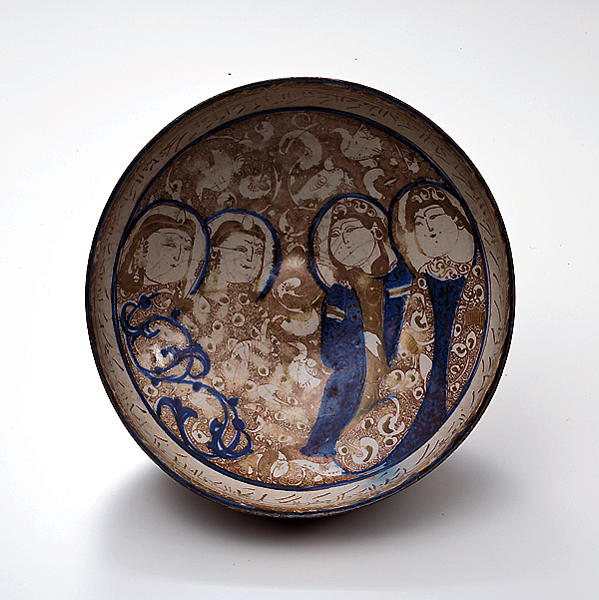Bowl with Four Figures
- Iran, Kashan
- Saljuq period
- 13c
- Fritware slip
- H-10.7 D-20
Catalogue Entry
Lusterware is one of the techniques that Islamic potters could justifiably be proud of, along with mina'i ware. Together, they epitomize the gorgeous and dazzling nature of Islamic art. "Luster" means "brilliance," and is used to describe colored ware characterized by a shimmering metallic gloss.
In lusterware, the surface of the body is tin glazed for a milky-white effect, and the designs are drawn on the surface using metal oxides. Then the ware is baked at a low temperature in a reducing atmosphere. On the surface of the ware, an extremely thin film with a gloss of metals such as gold, silver, and copper forms the design. The white ground color sometimes becomes yellowish or brownish, because of subtle differences in firing temperature, atmospheric pressure, and moisture, as well as individual characteristics of fuels and glazes. The failure rate was extremely high, and a change in weather during firing could doom an entire kiln load.
Themes of lusterware design range from traditional court scenes to illustrations of Shiism and Sufism (Islamic mysticism).1 There is no doubt that not only the rulers of the day patronized the arts; religious leaders, intellectuals, and other influential people also contracted potters to decorate wares with religious themes.
The two pairs of women drawn on this work might be noble persons, judging from their hair decorations, ornaments, showy clothes, and voluptuous figures. That it may be an outdoor scene is suggested by a bird, which is the same as those that appear to be flying in the sky, that appears between the facing figural groups. Are these people enjoying conversation, reciting poetry, or meditating? Or are they musing idly on dreams and illusions? It is difficult to fathom just what they are doing. Parts of the garments, halos, and arabesques are drawn in cobalt blue, which might indicate that this is an unfinished piece. This kind of underglaze painting is a well-known characteristic of Kashan lusterware.
TS
l. Hillenbrand 1955.
